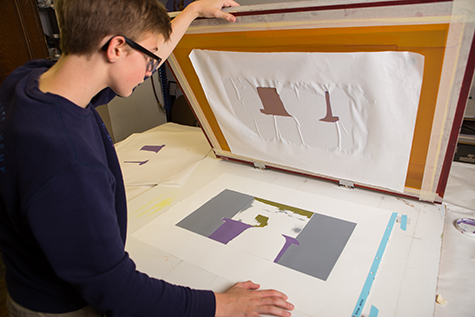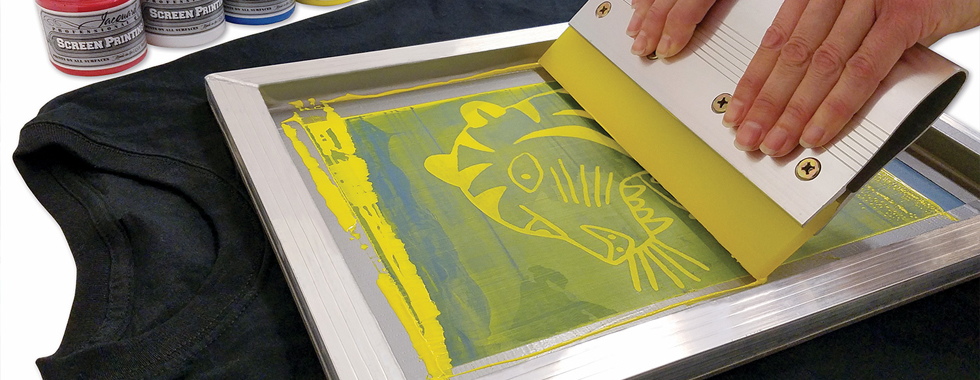The Vital Guide to Recognizing Screen Printing and Its Versatile Utilizes
Screen printing has a rich background that dates back to ancient times, advancing right into a sophisticated method used throughout various markets today. This overview explores the details of the screen printing process, describing its applications in fashion, advertising and marketing, and home decoration - 10:9 Design Abilene. Comprehending these principles can open up innovative possibility for both commercial and artistic tasks. The following sections will certainly disclose necessary suggestions and methods to boost one's screen printing undertakings
The History of Screen Printing
Although screen printing has origins that map back centuries, its development mirrors the creative and technical innovations of various societies. Stemming in old China, the strategy was originally made use of for enhancing fabrics and later infect Japan, where it came to be indispensable to Ukiyo-e woodblock printing. The approach changed to Europe in the 18th century, where it obtained popularity among artisans and commercial printers. The innovation of photo emulsion in the 20th century revolutionized screen printing, enabling for even more complex styles and higher efficiency. Artists like Andy Warhol further propelled its popularity, making use of the tool to create iconic works that blended commercialism and fine art. By the late 20th century, screen printing had actually developed itself as a flexible method, employed in style, advertising and marketing, and great art. Today, it remains to progress, integrating electronic modern technology and broadening its applications across numerous sectors.
The Screen Printing Process Explained
Screen printing transforms imaginative visions right into tangible styles through a collection of specific steps. An image is produced and then moved onto a screen, usually made of fine mesh fabric extended over a structure. A light-sensitive solution is applied to the screen, which is revealed to light, solidifying in areas not covered by the image. After washing out the unhardened solution, a stencil is formed.
Next off, the screen is placed over the substrate, whether it be textile, paper, or one more product. Ink is then pressed via the open locations of the stencil using a squeegee, transferring the style onto the substrate listed below. This process can be duplicated for numerous colors, calling for different screens for each color. Finally, the printed item is cured utilizing heat to guarantee the ink sticks effectively, causing a resilient, vivid design on-line.
Kinds Of Screen Printing Techniques

Additionally, specialized methods, such as discharge screen printing, get rid of color from the fabric to develop softer prints, while foil screen printing uses metallic aluminum foil to achieve a shiny surface (10:9 Design Abilene). Each method uses distinctive qualities, catering to different imaginative needs and manufacturing ranges, ultimately broadening the opportunities within the screen printing domain
Applications of Screen Printing in Different Industries

In addition, the signage and marketing markets utilize screen printing for producing eye-catching screens and banners. This technique enables bold colors and complex styles that record attention. In electronics, screen printing is utilized for using conductive inks to motherboard, essential for element connections. The home décor market embraces screen printing to generate distinct layouts on fabrics and wall art. On the whole, screen printing functions as a vital tool across diverse fields, improving products with personalized and visually appealing graphics.
Tips for Successful Screen Printing Projects
While try this site undertaking a screen printing project, careful attention to detail can considerably boost the last end result. Initially, picking high-grade products is crucial; this consists of the screen, inks, and substrates. Utilizing proper mesh matters can impact ink deposition and detail resolution. Preparation is just as vital; detailed cleansing of displays and appropriate exposure times guarantee crisp prints.
Next off, precise registration is crucial for multi-color prints. Utilizing placement tools can help achieve specific layering. Furthermore, testing prints on scrap products before production aids determine prospective concerns without losing resources.

Frequently Asked Inquiries
What Products Are Ideal for Screen Printing on Textile?
Cotton and polyester blends more helpful hints are excellent for screen printing on textile as a result of their longevity and ink absorption. Additionally, specialty textiles like silk or canvas can generate one-of-a-kind appearances and surfaces, improving the overall design high quality.
How Do I Clean and Maintain Screen Printing Tools?
To cleanse and preserve screen printing tools, one must regularly wash screens with appropriate solvents, evaluate mops for wear, lubricate relocating components, and store all products in a dry, dust-free environment to lengthen their life expectancy.
What Are the Environmental Influences of Screen Printing?
Screen printing can have considerable environmental influences, including chemical waste from inks and solvents, water use during cleaning procedures, and energy intake. Eco-friendly products and sustainable practices are essential for reducing these unfavorable effects.
Can Screen Printing Be Done in your home Efficiently?
Screen printing can be properly done at home with the right products and strategies. Enthusiasts can develop high quality prints, though success relies on their skill degree, equipment, and understanding of the procedure included.
What Are the Expenses Associated With Starting a Display Printing Business?

Starting a screen printing business includes expenses for tools, materials, and work area. Preliminary costs commonly range from a few hundred to a number of thousand dollars, depending upon the range, top quality of equipment, and desired production capacity.
Screen printing has a rich history that dates back to ancient times, developing into an advanced strategy made use of throughout numerous sectors today. An additional strategy, rotating screen printing, uses round displays, promoting continual printing on textile rolls, thus improving efficiency for large-scale productions. Additionally, specialized methods, such as discharge screen printing, eliminate dye from the fabric to produce softer prints, while foil screen printing applies metallic aluminum foil to accomplish a glossy surface. In the fashion sector, screen printing is extensively used to produce dynamic layouts on garments, making it possible for brands to showcase their unique designs. Cotton and polyester blends are excellent for screen printing on textile due to their toughness and ink absorption.